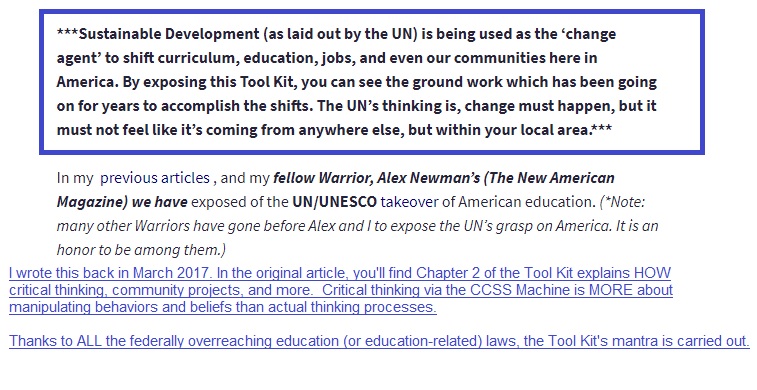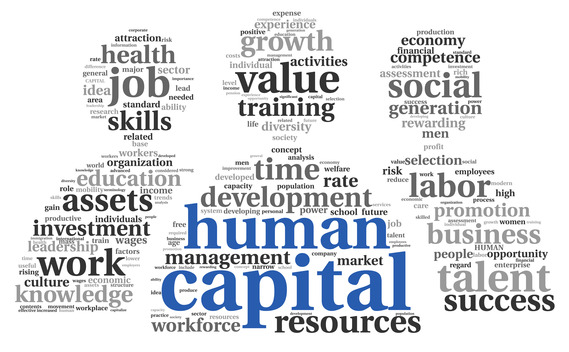Anti Fed Ed Warriors, in this, the final installment of my September 2019 series on what DC’s calling “Workforce Development Month”, I hope you’ve seen how toxic these overreaches into education have become. (*Note: This is an older image I made back when we were fighting against John King’s confirmation as U.S. Sec. of Education.
Sec. DeVos has applauded and upheld this federal web of educratic workforce pigeonholing.)
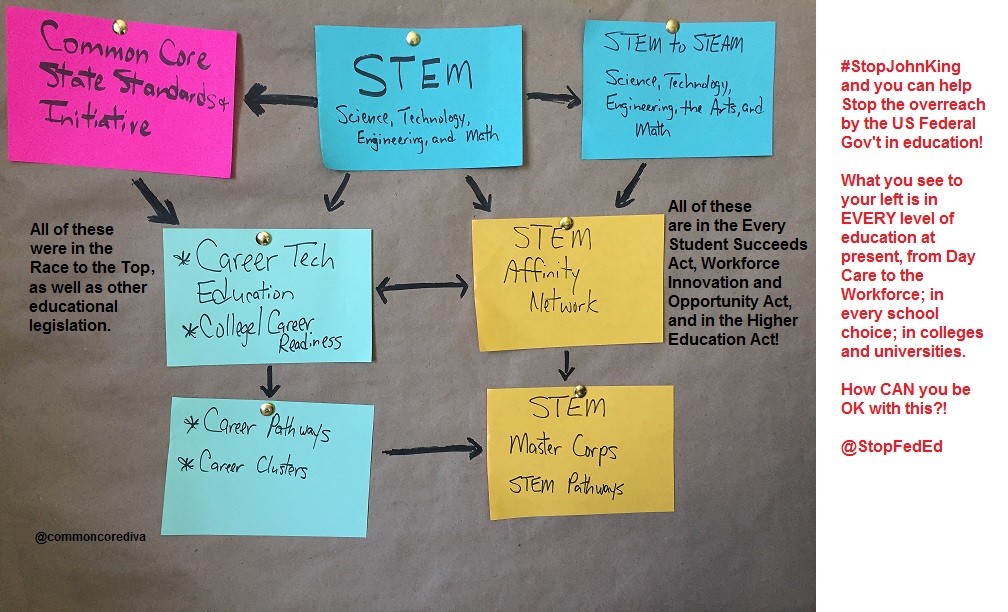
However, DC’s just one part of the puzzle for academics to shift to workforce training.
SIGs (Special Interest Groups) are also ready, willing, and, able to pigeonhole every one of us into a predetermined job.
Remember how the Business Roundtable was ever so quick to endorse the Common Core State Standards (CCSS)? Since ESSA’s passage (Every Student Succeeds Act), BR hasn’t taken their support away. In fact, they’ve increased it.
Did you know the BR has a WPI now? WPI is short for Workforce Partnership Initiative. Ten regions across America are using education and communities to build a national network of workforce preparing hubs.
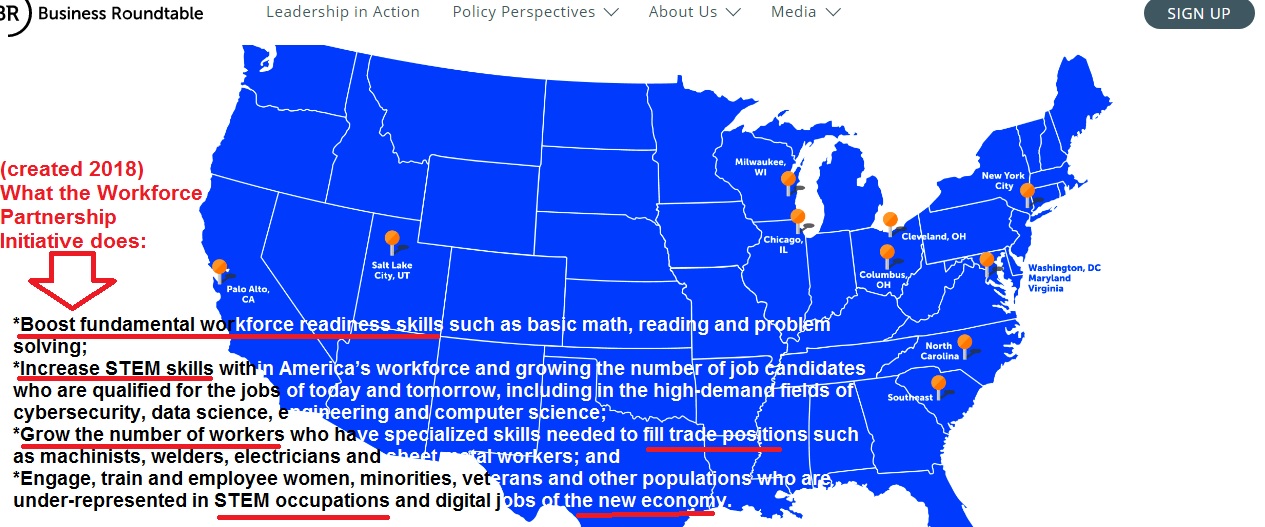
Is BR the ONLY SIG to do this? Hardly. Corporations are not SIGs. They may have foundations tied to them which are focus on issues like SIGs, but to list each and every one would take hundreds of articles. In my research I’ve found very few corporations (American based or not) which haven’t jumped into the education/workforce efforts from the CCSS Machine.
So, we know BR’s involvement. What about a SIG like NASBE (National Assoc. of State Boards of Education)?
What has NASBE been doing to contribute to the education/workforce pipeline?

Setting Brushfires, Where I First Discussed NASBE’s Latest:
Warriors, I first revealed some of what I’ve heard on the webinar on the latest episode of my weekly Setting Brushfires appearance. (*Note: in case the embedded link to the video doesn’t work, here’s the homepage for Setting Brushfires. You can scroll down and see the episode for 9/25/19. You can also click on the link with my picture to offer any financial support for my research and travel to speaking engagements.)
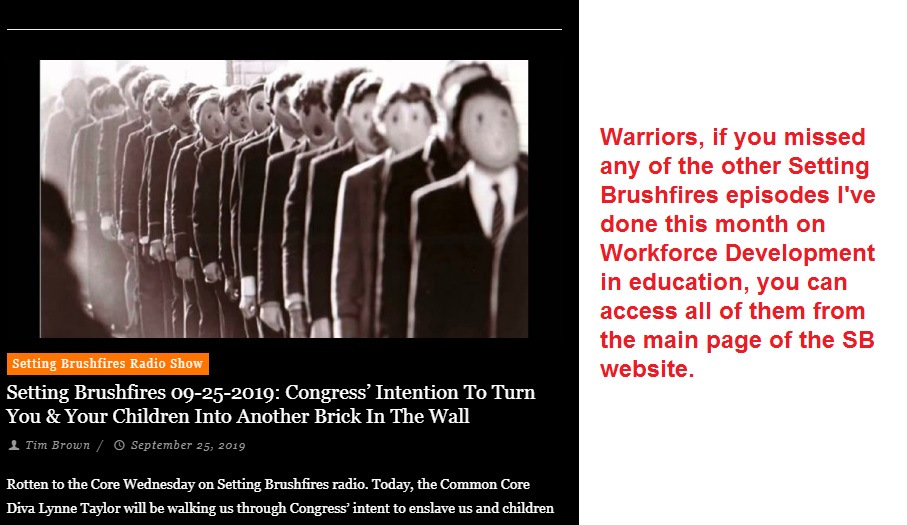
The remainder of this article will reveal exactly what NASBE’s doing to pigeonhole not only Johnny and Suzy, but all of us.
************************************************
The Webinar, Itself:
Warriors, NASBE/AIR spent just over 1 hour ‘discussing’ (really, it was propaganda) why everyone should be pleased about an education/workforce pipeline from a federal level. Within the hour, there were lots of colorful slides (as if color would help detract from the global CCSS Machine agenda for barely educated citizens)
Why should we all be pleased? According to the research of AIR, ‘at one time or another every citizen will find themselves revisiting education again’. (Note: the ‘lifelong learning’ so embraced by the UN/World Bank and embedded in the SDGs (Sustainable Development Goals) is becoming our reality..not just our kids’)
It was also disclosed that the webinar was a follow-up meeting to a March 2019 federal education/workforce pipeline meeting in DC. In attendance were members of AIR, NASBE, and the Asst. Sec. of the U.S. Dept. of Education, Scott Stump.
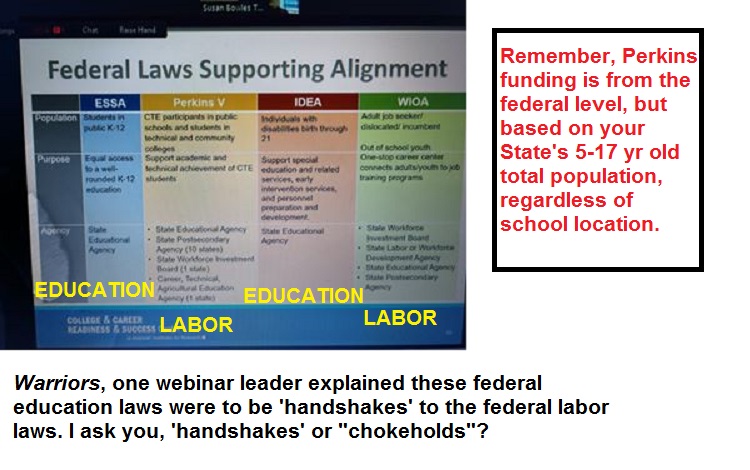
If you’d like to listen to the ‘discussion’, here’s the link. You will need to register to receive the archived version.
I’m sharing various slides, screen shots, and, notes I took, below.
Education/Workforce Propaganda:
Before I share the NASBE/AIR garbage, I’d like to point out, we already have a federally led education/workforce pipeline. We’ve had one since WIOA (Workforce Innovation and Opportunity Act). It got a ‘bonus’ when ESSA was made into federal law as well. If we remember the SLDS and WQDI (Student Longitudinal Data System and Workforce Quality Data Initiative), then we know the pipeline between education and labor.
AIR/NASBE’s work is to simply improve upon the pipeline by using GIS (geographic information system) data. This data is vital for the federal ed/workforce pipeline.
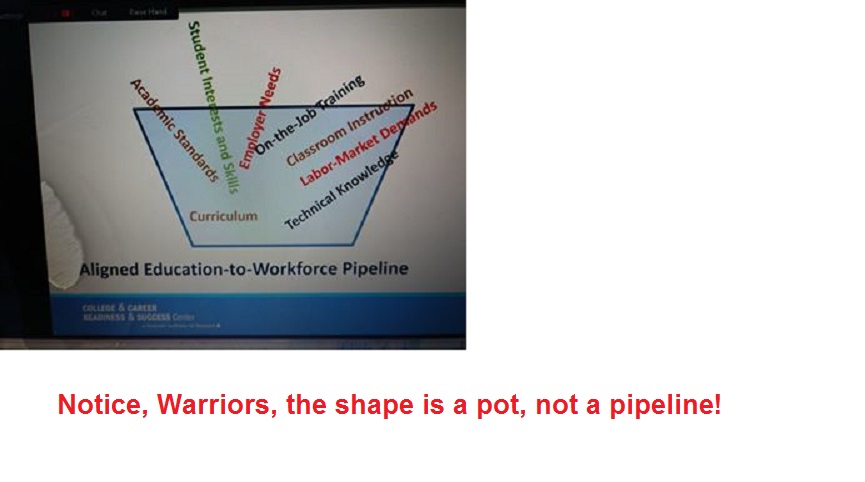
How so? Because education is becoming all about work-based learning (WBL), it makes sense to map those places using WBL and attach to the geography. Think layers of data. With one or two clicks, this type of map can literally point our students and teachers (along with the rest of us) to the precise spot best suited for our work-based learning and earning.

At least 11 different data sets are used in the AIR’s research to create this layered map.
Career Pathways from every school district in your State; all CTE organizations, departments, and extra-curricular clubs; all post-secondary information; drop out rates; reduced/free lunches; U.S. Census data; job growth; job vacancies; business/industry wages; and, a social needs index. These were mentioned on the webinar. However, if you’d like to see all the data systems they didn’t mention, go here. Even more information can be found on AIR’s College/Career Success Centers blog.
**************************
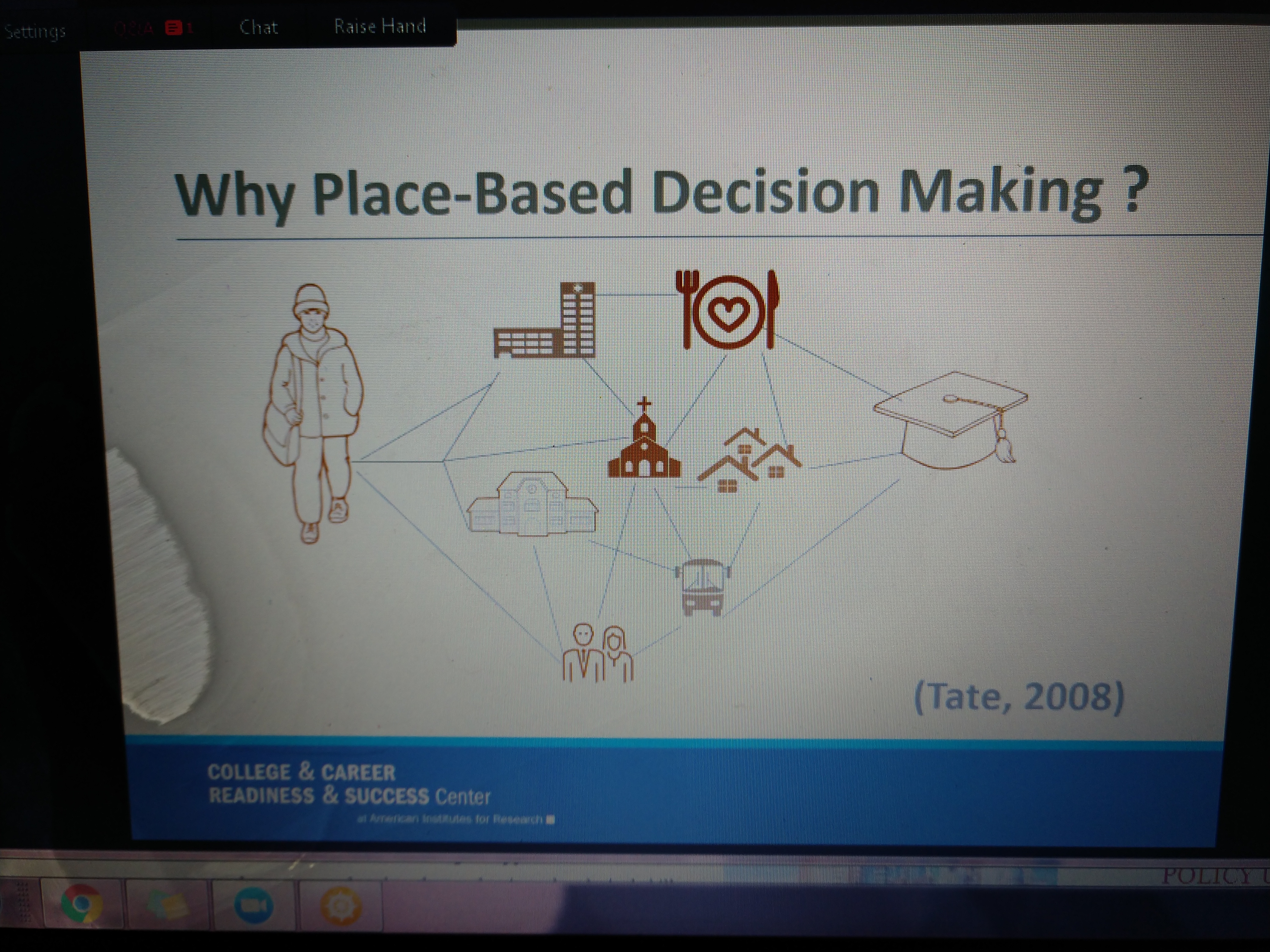
Another propaganda piece brought up in the webinar is how a WBL/GIS map can help your community be a part of the educational landscape. Above, you see it’s called ‘place based decision making’. Do you see the ties to the churches? The ties to the services in our communities. It was shared that this type of decision making will tie education and workforce to your rural areas, your energy sources, and other locations. How? Via Career Pathways and registered apprenticeships. There are other ways, but these are the two most embraced at a federal level.
By using the map, you can better align schools to workforce partners. One of the ‘beauties’ of the WBL/GIS map combining education to workforce is that regionalism can thrive. (*Note: Regional specific education was embedded in ESSA. Regionalism is also a UN tactic from the SDGs.)
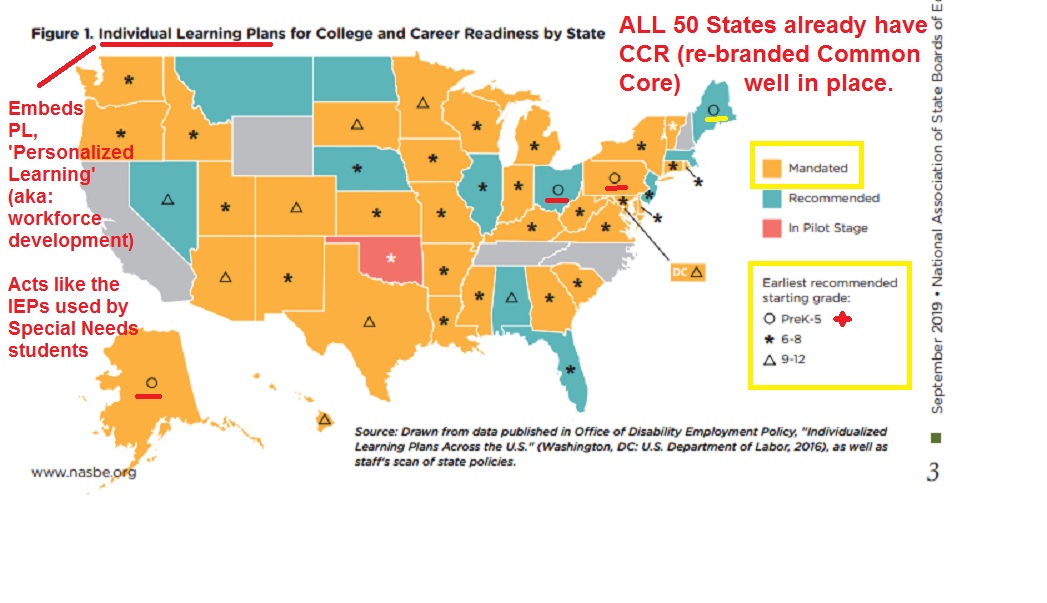
As far as parents and taxpayers being considered in this pipeline as ‘stakeholders’, forget it. The webinar featured the State of KS as a role model for all you’ve seen so far.
The list of ‘stakeholders’ in charge of this WBL/GIS map were:
The Commissioner of State Education; a deputy officer from the KS Dept. of Education; a Governor’s Office Education Consultant; AIR’s CCRS Center representatives; KS Dept. of Labor; KS Dept. of IT; KS legal representatives; KS CTE/IPE (Career Tech Education/Individual Program of Education); researchers; KS Dept. of Commerce; and, Apprenticeship representatives.
For KS, the WBL/GIS map can help students in all 5 economic regions plot their learning/earning opportunities. Supposedly KS has been highly successful in embedding SEL (Social Emotional Learning) in work-based learning. The justification is ‘better employability skills’. Most involve STEM (Science, Technology, Engineering, and, Math). To date at least 26 SEL/STEM markers have been embedded in the WBL/GIS map.
In the link above, you’ll find at least 17 of the markers. The SEL/STEM markers were combined in a cross-walk with employability skills.

It was brought to light that the general public (in KS and elsewhere) don’t really know about all this yet. Especially the WBL/GIS maps. OH is also in the midst of building this type of map. Did you see that OH is a State where CCR begins in PreK? NASBE would like to see a national mandate for work-based learning via CTE begin in Kindergarten. Why? Start students early in the learn to earn system.
If you’d like to see the Sept. 2019 publication spewing even more education/workforce pipeline propaganda, go here.
Closing:
Warriors, I hope you’ve been able to learn much during this series. In all, there are 7 articles. October is quickly approaching. I’ll be on the road for most of October. I can tell you my next topic will center around the UN (UN Day is 10/24) and then continued overreach in education.
My final thought on this ‘National Workforce Development’ Month. Teachers are going to be just as workforce based trained and credentialed as the rest of us. ESSA mandated that. The NASBE plan embeds it.
I long for the days when teachers would actually lead you in learning and discovery.
The way in which our federal overreaches from academics to workforce are going. Soon we won’t have any teachers. Simply the government pigeonholing us into jobs we will be trained for. (*Note: my apologies to the creator of this image.)
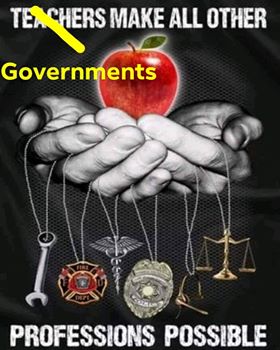
Part One in this series.
Part Two
Part Three
Part Four
Part Five
Part Six
